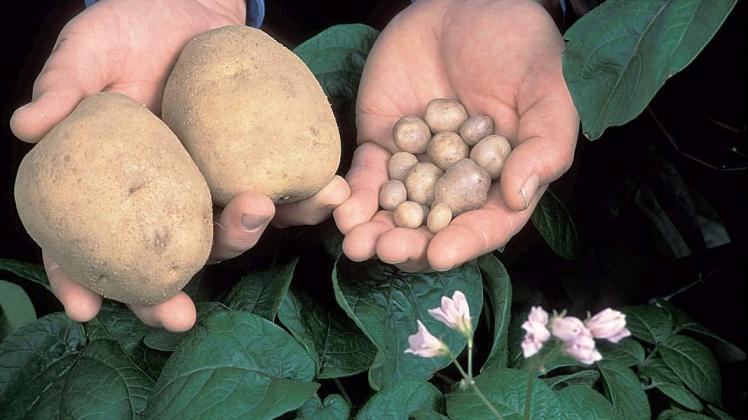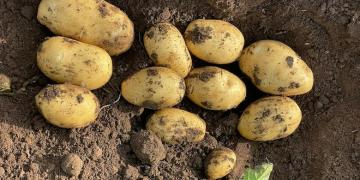EEUU: Researchers use wild potatoes to develop better hybrids
Potato breeders say potatoes growing in the wild hold the answers to many of the potato industry’s current and future challenges.

John Bamberg has explored one of the nation’s most important Native American archaeological sites, but instead of seeking clues to a past civilization, he was searching for solutions to many of the challenges facing the potato industry.
Bamberg, a project leader at the USDA Potato Introduction Station in Sturgeon Bay, Wis., has discovered that Mesa Verde National Park in southwest Colorado is not only home to cliff-dwelling Ancestral Pueblos, but also to the nation’s most diverse population of a wild potato species.
Bamberg’s facility maintains seed and tissue cultures of wild potato populations from around the world. To the researchers and breeders who request material from him, wild spuds represent a vast pool of genes that may allow them to transfer desirable traits such as disease and pest resistance to new potato varieties they develop.
Bamberg speculates potatoes were a staple of the diet of Mesa Verde’s ancient inhabitants. The potatoes were likely obtained via a trade route extending into Central and South America, where they originated.
“There’s an absolutely gigantic population (of potatoes) there,” Bamberg said. At Mesa Verde alone, Bamberg’s exploration increased the diversity of his facility’s collection of one wild potato, Solanum jamesii, by almost one-third.
He believes there may be many more as-yet undiscovered sites, as many botanists are apt to miss the small plants.
“There are about 5,000 total wild accessions,” Bamberg said, referring to different populations of spuds within a common species. “There are species you can look at and say, ‘Oh, that’s a potato.’ Others look very strange, with leaves almost like marigolds or African violets. However, they all have in common the capacity to form small potatoes underground.”
Most cultivated potatoes are considered to be a single species, Solanum tuberosum, Bamberg said.
Latin America, where potatoes originated, is considered the treasure trove of wild material. Bamberg, however, specializes in seeking wild spuds closer to home. There are roughly 100 known wild potato species throughout the Americas. Two wild species — S. jamesii and S. fendleri — are scattered around Colorado, Utah, Arizona, New Mexico and Texas.
Researchers say there’s an added urgency to broaden their collections, given the threats to wild potato habitat such as development, erosion and climate change.
Breeding wild
Accessions of S. Jamesii are of special interest to breeders. They are known to possess some anti-cancer properties, strong late blight resistance and other desirable qualities.
The catch is S. Jamesii is evolutionarily far different from today’s cultivated potatoes, making it extremely difficult for breeders to cross the two. Last summer, Bamberg’s lab was able to produce the first six hybrids ever resulting from S. Jamesii using a high-tech double-pollination method.
Bamberg’s team also works with the numerous species found in Latin America. One such species, S. microdontum, produces tubers that don’t turn green when exposed to light. Greening is a common problem among fresh potatoes exposed to grocery store lighting.
Upon hearing of Bamberg’s work with S. microdontum, Rich Novy, a USDA-Agricultural Research Service potato breeder in Aberdeen, Idaho, requested selected stocks from the gene bank. Novy currently has families of S. microdontum crosses growing in his greenhouse.
Novy has also identified a significant gene for potato leafroll virus resistance in a wild species and bred crosses with the wild species S. berthaultii that exhibit extreme resistance to potato virus Y. This year, the Tri-State Potato Breeding Program is scheduled to release Payette Russet, a potato originating from Novy’s program with PVY resistance from another wild source.
“A lot of (wild) material is in advanced breeding clones that are currently being evaluated for release,” Novy said.
Often, breeders look to wild South American material believing it may have co-evolved with diseases and developed natural resistance. But even in the case of zebra chip, a relatively new disease that sullies spuds with bands that darken when fried, Novy believes wild populations offer great promise.
“There may be genes conferring resistance to another bacterial pathogen that also confer resistance to zebra chip,” Novy said.
Novy suspects the wild species S. chacoense may have zebra chip resistance in its background.
“I think it is good to have the gene bank with its associated species to be able to address new diseases or new variants of established diseases,” Novy said. “Ideally, you want to look at the cultivated bank to begin with, but if it’s not there, go to the wild species.”
Broader gene pool
Other breeders who use wild potato material often rely on Chuck Brown for re-breeding — or making the initial crosses to develop wild spuds into a form that more closely resembles a cultivated potato. These crosses can be more easily bred with cultivated potato species.
Brown, a USDA-ARS breeder in Prosser, Wash., has leaned heavily on the wild species S. bulbocastanum found in Mexico. The species is resistant to Columbia root-knot nematode, and advanced breeding lines from its crosses could save growers fighting the pest in excess of $300 per acre in fumigation costs.
Brown first started working with S. bulbocastanum when Bamberg sent him material in 1988.
“If you ask me, for a lot of things that are on our minds right now where I would go to search (for resistance), I would go into S. bulbocastanum,” Brown said. “The reason for that is so many resistances have been found to late blight and other things.”
Brown said it could still be five years to a decade before the first varieties with S. bulbocastanum in the background are released.
Wild potatoes have already helped the industry develop a host of specialty varieties with resistance to diseases such as black dot, potato mop top virus and powdery scab, and Brown has a line with wild parentage, PORO6v12-3, in advanced trials that resists all strains of PVY and tobacco rattle virus.
It’s no surprise to Brown that wild spuds often provide the answers to industry challenges while the bank of cultivated material falls short. Wild species result from millions of years of evolution, while cultivated spuds have existed for a few thousand years. Humans have selected potatoes for qualities such as pleasing colors, but most wild spuds are white. And the spuds in the Andes Mountains of South America that were chosen as the basis for cultivated potatoes lacked strong resistance to diseases, Brown said.
“The wild species are more likely to have strong resistance genes,” Brown said.
A wild idea
Officials of the Idaho Potato Commission believe wild potatoes could play a role in helping Eastern Idaho farmers cope with pale cyst nematode. The discovery of the pest has led to a quarantine in the area.
Growers with infested fields, all confined to 23 square miles in Bonneville and Bingham counties, have been prohibited from planting spuds, which provide a host crop for PCN. The commission recently secured $150,000 through USDA’s Specialty Crop Research Initiative to screen about 10 wild potato species for PCN resistance. They in turn will be used to breed resistant commercial varieties.
Pat Kole, the commission’s vice president, said the timing is ideal because scientists in Peru have an especially robust collection of wild material that they recently finished cataloging.
Louise-Marie Dandurand, director of University of Idaho’s Pale Cyst Nematode Project, will help screen the material for the commission. She’s also involved in a project that was recently awarded a $3 million grant to screen for resistance to pale cyst nematode and golden nematode in cultivated potatoes. Cornell University nematologist Xiaohong Wang hopes to identify a gene or family of genes in wild spuds responsible for PCN resistance.
Modern technology allows scientists to quickly isolate important genes through molecular markers. This has dramatically improved the science of breeding, so Bamberg envisions wild potatoes will become increasingly important to the industry.
“We’ve probably only just scratched the surface of finding useful traits in the gene bank’s germplasm, and there is probably much more diversity in the wild yet to be collected,” Bamberg said.
Fuente: http://www.capitalpress.com/Nation_World/Nation/20150806/researcher-use-wild-spuds-to-develop-better-hybrids




